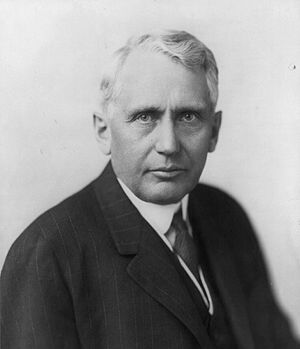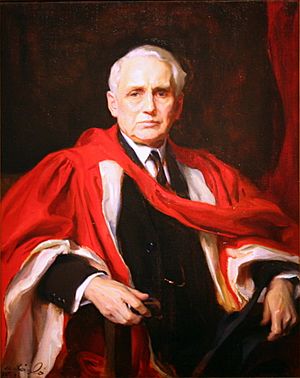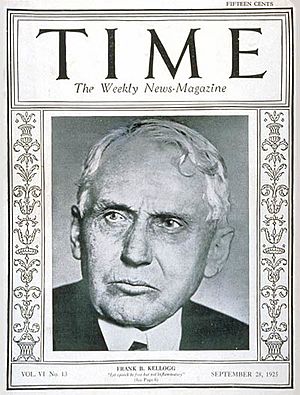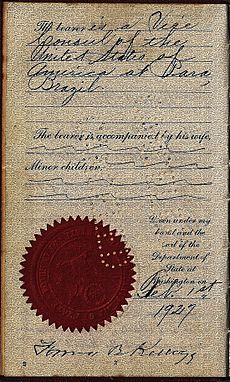Frank B. Kellogg facts for kids
Quick facts for kids
Frank B. Kellogg
|
|
|---|---|

Kellogg in 1912
|
|
| Associate Judge of the Permanent Court of International Justice | |
| In office September 25, 1930 – September 9, 1935 |
|
| Preceded by | Charles E. Hughes |
| Succeeded by | Manley O. Hudson |
| 45th United States Secretary of State | |
| In office March 5, 1925 – March 28, 1929 |
|
| President | Calvin Coolidge Herbert Hoover |
| Preceded by | Charles Evans Hughes |
| Succeeded by | Henry L. Stimson |
| United States Ambassador to the United Kingdom | |
| In office January 14, 1924 – February 10, 1925 |
|
| President | Calvin Coolidge |
| Preceded by | George Harvey |
| Succeeded by | Alanson B. Houghton |
| United States Senator from Minnesota |
|
| In office March 4, 1917 – March 3, 1923 |
|
| Preceded by | Moses E. Clapp |
| Succeeded by | Henrik Shipstead |
| County Attorney of Olmsted County | |
| In office January 1, 1882 – January 1, 1887 |
|
| Preceded by | Halfton A. Eckholdt |
| Succeeded by | Burt W. Eaton |
| City Attorney of Rochester | |
| In office 1878–1881 |
|
| Preceded by | Royal H. Gove |
| Succeeded by | W. Logan Breckenridge |
| Personal details | |
| Born |
Frank Billings Kellogg
December 22, 1856 Potsdam, New York |
| Died | December 21, 1937 (aged 80) St. Paul, Minnesota |
| Political party | Republican |
| Spouse | Clara Cook |
| Awards | Nobel Peace Prize 1929 Legion of Honour |
| Signature | |
Frank Billings Kellogg (born December 22, 1856 – died December 21, 1937) was an important American lawyer and politician. He served as a U.S. Senator and later as the U.S. Secretary of State. He is most famous for helping to create the Kellogg–Briand Pact. This special agreement aimed to prevent wars. Because of his work on this pact, he won the Nobel Peace Prize in 1929.
Contents
Early Life & Legal Career
Frank Kellogg was born in Potsdam, New York, on December 22, 1856. When he was nine years old, his family moved to Minnesota.
Kellogg did not go to college or law school. Instead, he learned law by working in a lawyer's office. He started practicing law in Rochester, Minnesota, in 1877. He worked as the city attorney for Rochester from 1878 to 1881. Then, he became the county attorney for Olmsted County, Minnesota, from 1882 to 1887. In 1886, he moved to St. Paul, Minnesota.
In 1905, President Theodore Roosevelt asked Kellogg to work for the government. He helped with important legal cases about unfair business practices. These cases were called "antitrust" cases. For example, he led a case against the Union Pacific Railroad in 1908. His most famous case was against Standard Oil in 1911. After winning this case, he became the president of the American Bar Association (1912–1913).
Political Roles
Serving in the U.S. Senate
In 1916, Kellogg was elected as a Republican to the United States Senate from Minnesota. He served in the Senate from 1917 to 1923. During this time, he supported the Treaty of Versailles. This treaty officially ended World War I. He lost his re-election in 1922. In 1923, he attended an important meeting in Chile.
Ambassador to Great Britain
In 1924, President Calvin Coolidge appointed Kellogg as the U.S. Ambassador to Great Britain. An ambassador is a country's official representative in another country. He served in this role from January 1924 to February 1925. He then left this job to become the Secretary of State.
Becoming Secretary of State
From 1925 to 1929, Frank Kellogg served as the United States Secretary of State. This is a very important job in the U.S. government. The Secretary of State is the President's main advisor on foreign policy. This means they deal with how the U.S. interacts with other countries.
As Secretary of State, Kellogg helped improve relations between the U.S. and Mexico. He also helped solve a long-standing border dispute between Peru and Chile.
The Kellogg–Briand Pact
Kellogg's most important achievement was the Kellogg–Briand Pact. This agreement was signed in 1928. It was proposed by the French foreign minister, Aristide Briand. The main goal of the treaty was to make war illegal as a way for countries to solve their problems.
Almost every country in the world signed this pact. It became a legal basis for judging war leaders after World War II. For his work on this important peace treaty, Frank Kellogg was awarded the Nobel Peace Prize in 1929.
Later Work in Law
After serving as Secretary of State, Kellogg became an associate judge. He worked at the Permanent Court of International Justice from 1930 to 1935. This court helped settle disagreements between countries.
Kellogg grew up on a poor farm in Minnesota. He did not have much formal schooling. He was known for being open and easy to talk to. He focused a lot on relations with countries in Latin America. He also worked to protect China from threats from Japan.
Personal Life
In 1886, Frank Kellogg married Clara May Cook. He was also a member of the Masonic Lodge in Rochester.
Kellogg passed away from pneumonia on December 21, 1937, just before his 81st birthday. He was buried in Washington, D.C.
Legacy
In 1937, Frank Kellogg helped create the Kellogg Foundation for Education in International Relations. This foundation is at Carleton College. His home in St. Paul, the Frank B. Kellogg House, is now a special historic landmark.
Several places and things were named in his honor:
- Kellogg Boulevard in downtown Saint Paul.
- Kellogg Middle School in Shoreline, Washington, and Rochester, Minnesota.
- A Liberty ship named the SS Frank B. Kellogg.
Frank B. Kellogg's important papers are kept at the Minnesota Historical Society. They include his letters, awards, and other documents.
See also
 In Spanish: Frank Billings Kellogg para niños
In Spanish: Frank Billings Kellogg para niños
- List of people on the cover of Time magazine: 1920s





